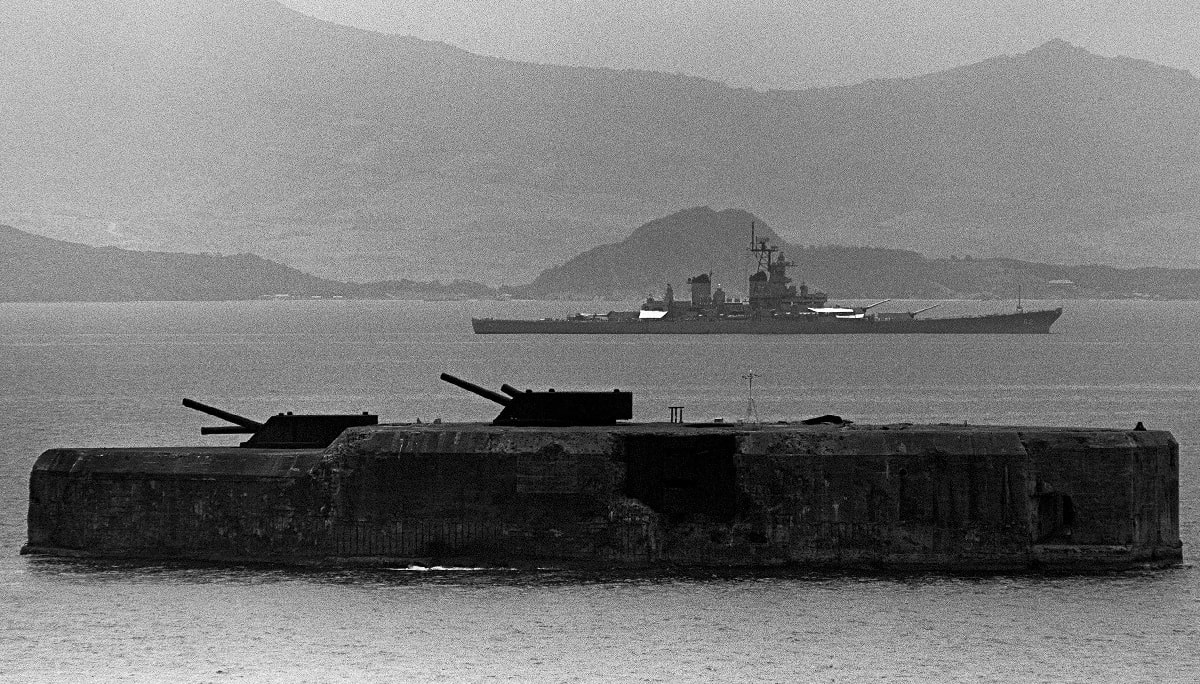Ten hours after the attack on Pearl Harbor, over 100,000 Japanese soldiers invaded the Philippines. Within days, Japanese soldiers were landing on beaches in the north and south of the island of Luzon.
Their objective was to take the Philippine capital of Manila and force US Army Gen. Douglas MacArthur and his combined American and Filipino garrison to surrender.
As Japanese troops and aircraft got closer to Manila Bay, they ran into an obstacle that wasn’t going down without a fight: Fort Drum.
With a garrison of 240 men from the US Army’s 59th Coastal Artillery Regiment and armed to the teeth with massive coastal artillery guns, Fort Drum was known as a “concrete battleship.”
For five months, Fort Drum lived up to its moniker, firing hundreds of rounds at the attacking Japanese and enduring one of the most intense bombardments on a single position in the Pacific theater.
A concrete battleship
Fort Drum was built on a small rocky islet originally known as El Fraile Island, strategically located at the mouth of Manila Bay just south of Corregidor Island.
The Spanish had placed three 120 mm guns on the island, but like the rest of the Spanish defenses in the bay, they were woefully inadequate for defending the area from US forces during the Spanish-American War in 1898.
Determined not to make the same mistake in such a valuable port, the US Army Corps of Engineers built four forts in the bay between 1909 and 1916, one of which was Fort Drum.
El Fraile was completely leveled and rebuilt with a steel-reinforced concrete structure shaped roughly like a battleship. The structure was 350 feet long, rose 44 feet above sea level, and was 144 feet wide at its widest point.
The thickness of the walls ranged from 25 feet to 36 feet, and the “deck” was protected by 20 feet of reinforced concrete — making the fort virtually impregnable. A 60-foot tower for observation and fire control was also built.
Four 14-inch guns in two custom-built armored turrets were placed on the top of the structure, adding to its battleship-like appearance. Each gun could fire a 1,660-pound shell up to 11 miles. The fort also had two 6-inch guns in armored casements on each side and two 2-inch anti-aircraft guns.
The last American bastion at Manila
Fort Drum’s interior had accommodations, generators, a mess hall, medical facilities, and a communications hub, enabling it to operate even if cut off from friendly forces.
The range of Fort Drum’s guns and those of the other forts, made sailing into the Bay impossible for the Japanese navy. As a result, the area had to be taken with ground assaults by the invasion forces that landed to the north and south.
About a month into the invasion, Fort Drum came under aerial attack. Soon after, Japanese troops began bombarding the fort with artillery. The Japanese barrages, with 150 mm and 240 mm shells, were constant for months.
But Fort Drum’s structure held, and it returned fire with a vengeance. Its garrison lobbed hundreds of rounds at the attacking Japanese, destroying gun emplacements and inflicting heavy casualties.
Even after Bataan fell on April 10, 1942, Fort Drum’s guns were blasting away, attempting to protect the garrison of 13,000 US and Filipino troops at Corregidor.
As the Japanese assaulted Corregidor in troop barges on May 5, Fort Drum’s guns brought down a massive barrage even though smoke from the fighting obscured the barges.
“Just fire into the smoke anywhere between you and Cabcaben and you can’t miss them.” Corregidor’s garrison told Fort Drum’s commander, referring to a neighborhood on the mainland north of Corregidor.
The resulting barrage sank several of the troop barges. The guns fired until just minutes before Corregidor surrendered, leaving Fort Drum the last bastion of US resistance.
Running low on ammunition and supplies itself, Fort Drum surrendered soon after.
Despite being hit over 500 times by Japanese artillery and bombs, the fort was never penetrated. Not a single member of its garrison was killed and only five were injured.
Recaptured
The Americans disabled the fort’s guns before their surrender. The Japanese occupied the fort after the battle, but no effort was made to repair or replace them.
The Americans returned to Manila nearly three years later, and the Japanese garrison at Fort Drum was again the last bastion of resistance in a brutal fight for the city.
With the Japanese refusing to surrender and the fort still unable to be penetrated, the Americans decided to eliminate the defenders by pumping thousands of gallons of diesel fuel and gasoline into the air vents and detonating white phosphorus and 600 pounds of TNT.
The resulting explosion blew a 1-ton hatch on the fort 300 feet into the air, killed the entire Japanese garrison, and started a fire that lasted for days.
American troops were only able to enter the fort five days later, after the fires burned out and the heat dissipated.
Fort Drum was never reoccupied after the war. Abandoned but largely intact, it still stands today, with the remains of its 14-inch guns rusting away.
Benjamin Brimelow is a reporter at Business Insider.

